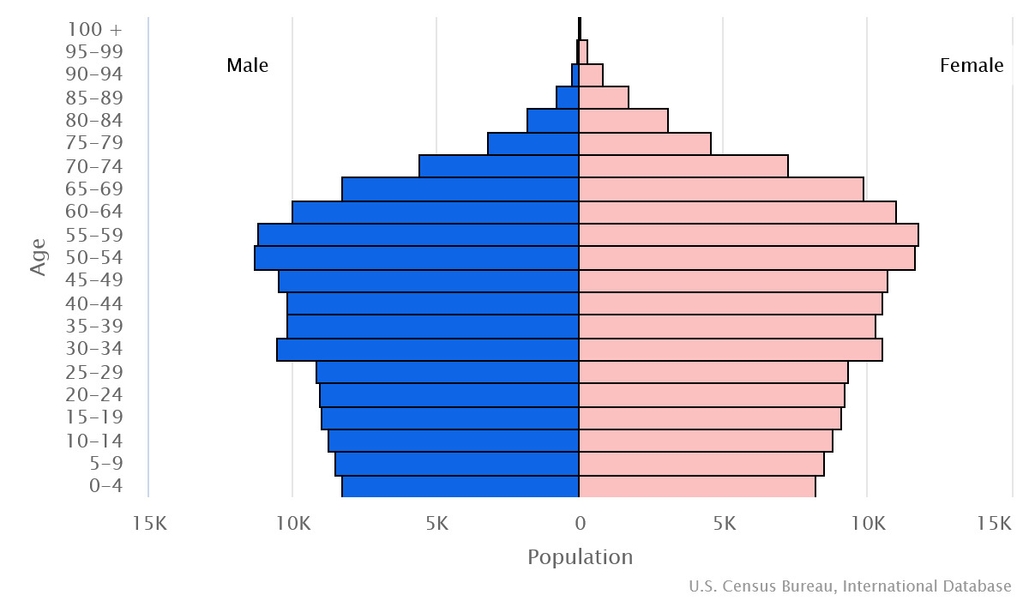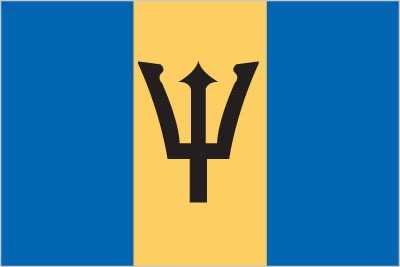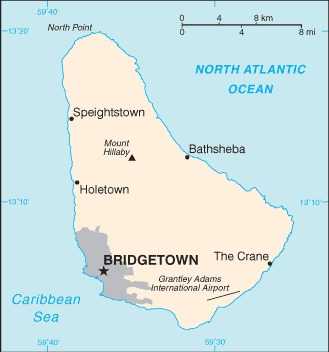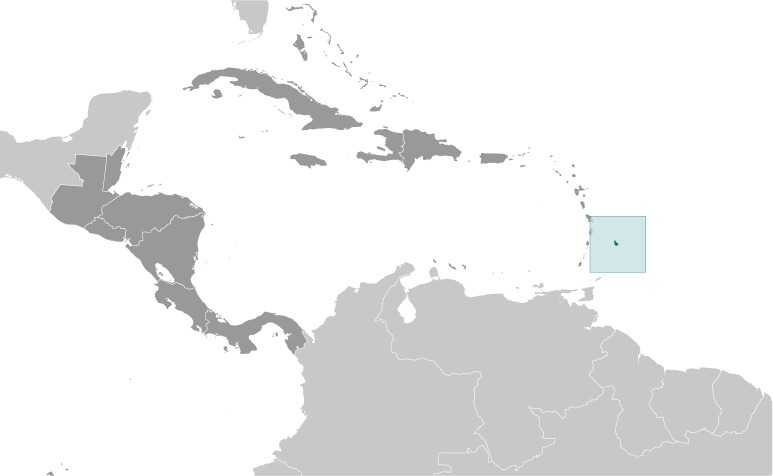Introduction
Background
Barbados was uninhabited when first settled by the British in 1627. Enslaved Africans worked the sugar plantations established on the island, which initially dominated the Caribbean sugar industry. By 1720, Barbados was no longer a dominant force within the sugar industry, having been surpassed by the Leeward Islands and Jamaica. Slavery was abolished in 1834. The Barbadian economy remained heavily dependent on sugar, rum, and molasses production through most of the 20th century. The gradual introduction of social and political reforms in the 1940s and 1950s led to independence from the UK in 1966. In the 1990s, tourism and manufacturing surpassed the sugar industry in economic importance. Barbados became a republic in 2021, with the former Governor-General Sandra MASON elected as the first president.
Visit the Definitions and Notes page to view a description of each topic.
Geography
Location
Caribbean, island in the North Atlantic Ocean, northeast of Venezuela
Geographic coordinates
13 10 N, 59 32 W
Map references
Central America and the Caribbean
Area - comparative
2.5 times the size of Washington, DC
Land boundaries
total: 0 km
Coastline
97 km
Maritime claims
territorial sea: 12 nm
exclusive economic zone: 200 nm
Climate
tropical; rainy season (June to October)
Terrain
relatively flat; rises gently to central highland region
Elevation
highest point: Mount Hillaby 336 m
lowest point: Atlantic Ocean 0 m
Natural resources
petroleum, fish, natural gas
Land use
agricultural land: 32.6% (2018 est.)
arable land: 25.6% (2018 est.)
permanent crops: 2.3% (2018 est.)
permanent pasture: 4.7% (2018 est.)
forest: 19.4% (2018 est.)
other: 48% (2018 est.)
Irrigated land
50 sq km (2012)
Population distribution
most densely populated country in the eastern Caribbean; approximately one-third live in urban areas
Natural hazards
infrequent hurricanes; periodic landslides
Geography - note
easternmost Caribbean island
People and Society
Population
total: 304,139
male: 146,587
female: 157,552 (2024 est.)
comparison rankings: female 180; male 182; total 181
Nationality
noun: Barbadian(s) or Bajan (colloquial)
adjective: Barbadian or Bajan (colloquial)
Ethnic groups
African descent 92.4%, mixed 3.1%, White 2.7%, East Indian 1.3%, other 0.2%, unspecified 0.3% (2010 est.)
Languages
English (official), Bajan (English-based creole language, widely spoken in informal settings)
Religions
Protestant 66.4% (includes Anglican 23.9%, other Pentecostal 19.5%, Adventist 5.9%, Methodist 4.2%, Wesleyan 3.4%, Nazarene 3.2%, Church of God 2.4%, Baptist 1.8%, Moravian 1.2%, other Protestant 0.9%), Roman Catholic 3.8%, other Christian 5.4% (includes Jehovah's Witness 2.0%, other 3.4%), Rastafarian 1%, other 1.5%, none 20.6%, unspecified 1.2% (2010 est.)
Age structure
0-14 years: 16.6% (male 25,273/female 25,284)
15-64 years: 67% (male 100,328/female 103,536)
65 years and over: 16.3% (2024 est.) (male 20,986/female 28,732)

Dependency ratios
total dependency ratio: 49
youth dependency ratio: 25.6
elderly dependency ratio: 23.4
potential support ratio: 4.3 (2021 est.)
Median age
total: 41.4 years (2024 est.)
male: 40.3 years
female: 42.5 years
comparison ranking: total 50
Population distribution
most densely populated country in the eastern Caribbean; approximately one-third live in urban areas
Urbanization
urban population: 31.4% of total population (2023)
rate of urbanization: 0.46% annual rate of change (2020-25 est.)
Major urban areas - population
89,000 BRIDGETOWN (capital) (2018)
Sex ratio
at birth: 1.01 male(s)/female
0-14 years: 1 male(s)/female
15-64 years: 0.97 male(s)/female
65 years and over: 0.73 male(s)/female
total population: 0.93 male(s)/female (2024 est.)
Infant mortality rate
total: 9.6 deaths/1,000 live births (2024 est.)
male: 11.1 deaths/1,000 live births
female: 8.1 deaths/1,000 live births
comparison ranking: total 137
Life expectancy at birth
total population: 79 years (2024 est.)
male: 76.3 years
female: 81.8 years
comparison ranking: total population 68
Gross reproduction rate
0.85 (2024 est.)
Contraceptive prevalence rate
59.2% (2012)
Drinking water source
improved: urban: NA
rural: NA
total: 98.8% of population
unimproved: urban: NA
rural: NA
total: 2% of population (2020 est.)
Current health expenditure
7.2% of GDP (2020)
Physician density
2.49 physicians/1,000 population (2017)
Hospital bed density
6 beds/1,000 population (2017)
Sanitation facility access
improved: urban: NA
rural: NA
total: 100% of population
unimproved: urban: NA
rural: NA
total: 0% of population (2020 est.)
Alcohol consumption per capita
total: 9.94 liters of pure alcohol (2019 est.)
beer: 3.66 liters of pure alcohol (2019 est.)
wine: 1.36 liters of pure alcohol (2019 est.)
spirits: 4.75 liters of pure alcohol (2019 est.)
other alcohols: 0.17 liters of pure alcohol (2019 est.)
comparison ranking: total 22
Tobacco use
total: 8.5% (2020 est.)
male: 15% (2020 est.)
female: 1.9% (2020 est.)
comparison ranking: total 144
Currently married women (ages 15-49)
57.1% (2023 est.)
Literacy
definition: age 15 and over can read and write
total population: 99.6%
male: 99.6%
female: 99.6% (2014)
Environment
Environment - current issues
pollution of coastal waters from waste disposal by ships; soil erosion; illegal solid waste disposal threatens contamination of aquifers
Environment - international agreements
party to: Biodiversity, Climate Change, Climate Change-Kyoto Protocol, Climate Change-Paris Agreement, Comprehensive Nuclear Test Ban, Desertification, Endangered Species, Hazardous Wastes, Law of the Sea, Marine Dumping-London Convention, Marine Dumping-London Protocol, Ozone Layer Protection, Ship Pollution, Wetlands
signed, but not ratified: none of the selected agreements
Climate
tropical; rainy season (June to October)
Land use
agricultural land: 32.6% (2018 est.)
arable land: 25.6% (2018 est.)
permanent crops: 2.3% (2018 est.)
permanent pasture: 4.7% (2018 est.)
forest: 19.4% (2018 est.)
other: 48% (2018 est.)
Urbanization
urban population: 31.4% of total population (2023)
rate of urbanization: 0.46% annual rate of change (2020-25 est.)
Air pollutants
particulate matter emissions: 9.79 micrograms per cubic meter (2019 est.)
carbon dioxide emissions: 1.28 megatons (2016 est.)
methane emissions: 2.35 megatons (2020 est.)
Waste and recycling
municipal solid waste generated annually: 174,815 tons (2011 est.)
municipal solid waste recycled annually: 15,733 tons (2015 est.)
percent of municipal solid waste recycled: 9% (2015 est.)
Total water withdrawal
municipal: 20 million cubic meters (2020 est.)
industrial: 10 million cubic meters (2020 est.)
agricultural: 5 million cubic meters (2020 est.)
Total renewable water resources
80 million cubic meters (2020 est.)
Government
Country name
conventional long form: none
conventional short form: Barbados
etymology: the name derives from the Portuguese "as barbadas," which means "the bearded ones" and can refer either to the long, hanging roots of the island's bearded fig trees or to the alleged beards of the indigenous Carib inhabitants
Government type
parliamentary republic; a Commonwealth realm
Capital
name: Bridgetown
geographic coordinates: 13 06 N, 59 37 W
time difference: UTC-4 (1 hour ahead of Washington, DC, during Standard Time)
etymology: named after a bridge constructed over the swampy area (known as the Careenage) around the Constitution River that flows through the center of Bridgetown
Administrative divisions
11 parishes and 1 city*; Bridgetown*, Christ Church, Saint Andrew, Saint George, Saint James, Saint John, Saint Joseph, Saint Lucy, Saint Michael, Saint Peter, Saint Philip, Saint Thomas
Independence
30 November 1966 (from the UK)
National holiday
Independence Day, 30 November (1966)
Legal system
English common law; no judicial review of legislative acts
Constitution
history: adopted 22 November 1966, effective 30 November 1966; Constitution (Amendment) (No. 2) Bill, 2021 establishes Barbados as a republic and revokes the earlier Order in Council
amendments: proposed by Parliament; passage of amendments to constitutional sections such as citizenship, fundamental rights and freedoms, and the organization and authorities of the branches of government requires two-thirds majority vote by the membership of both houses of Parliament; passage of other amendments only requires a majority vote of both houses; amended several times, last in 2021
note: following the transition to a republic in November 2021, the Government of Barbados in February 2022 began the process of establishing a constitution commission to review a new draft constitution
International law organization participation
accepts compulsory ICJ jurisdiction with reservations; accepts ICCt jurisdiction
Citizenship
citizenship by birth: yes
citizenship by descent only: yes
dual citizenship recognized: yes
residency requirement for naturalization: 5 years
Suffrage
18 years of age; universal
Executive branch
chief of state: President Sandra MASON (since 30 November 2021)
head of government: Prime Minister Mia MOTTLEY (since 25 May 2018)
cabinet: Cabinet appointed by the president on the advice of the prime minister
elections/appointments: president elected by an electoral college of both Houses of Parliament for a 4-year renewable term; election last held on 20 October 2021 (next to be held in); following legislative elections, the leader of the majority party or leader of the majority coalition usually appointed prime minister by the president; the prime minister recommends the deputy prime minister
election results: Sandra MASON elected as first president on 20 October 2021
Legislative branch
description: bicameral Parliament consists of:
Senate (21 seats statutory - 21 current; members appointed by the president - 12 on the advice of the prime minister, 2 on the advice of the opposition leader, and 7 at the discretion of the president; members serve 5-year terms)
House of Assembly (30 seats; members directly elected in single-seat constituencies by simple majority vote to serve 5-year terms)
elections: Senate - last appointments on 4 February 2022 (next appointments in February 2027)
House of Assembly - last held on 19 January 2022 (next to be held in January 2027)
election results: Senate - appointed - BLP 12, independent 9; composition - men 13, women 8, percentage women 38.1%
House of Assembly - percent of vote by party - BLP 69%, DLP 26.5%, other 4.5%; seats by party - BLP 30; composition - men 22, women 8, percentage women 26.7%; note - total Parliament percentage women 32.7%
note: tradition dictates that the next election is held within 5 years of the last election, but constitutionally it is 5 years from the first seating of Parliament plus a 90-day grace period
Judicial branch
highest court(s): Supreme Court (consists of the High Court with 8 justices) and the Court of Appeal (consists of the High Court chief justice and president of the court and 4 justices; note - in 2005, Barbados acceded to the Caribbean Court of Justice as the final court of appeal, replacing that of the Judicial Committee of the Privy Council (in London)
judge selection and term of office: Supreme Court chief justice appointed by the president on the recommendation of the prime minister and opposition leader of Parliament; other justices appointed by the president on the recommendation of the Judicial and Legal Service Commission, a 5-member independent body consisting of the Supreme Court chief justice, the commission head, and presidential appointees recommended by the prime minister; justices serve until mandatory retirement at age 65
subordinate courts: Magistrates' Courts
Political parties
Alliance Party for Progress or APP
Barbados Labor Party or BLP
Democratic Labor Party or DLP
International organization participation
ACP, ACS, AOSIS, C, Caricom, CDB, CELAC, FAO, G-77, IADB, IBRD, ICAO, ICCt, ICRM, IDA, IFAD, IFC, IFRCS, ILO, IMF, IMO, Interpol, IOC, ISO, ITSO, ITU, ITUC (NGOs), LAES, MIGA, NAM, OAS, OPANAL, OPCW, UN, UNCTAD, UNESCO, UNHCR, UNIDO, UPU, WCO, WFTU (NGOs), WHO, WIPO, WMO, WTO
Diplomatic representation in the US
chief of mission: Ambassador Noel Anderson LYNCH (since 11 January 2019)
chancery: 2144 Wyoming Avenue NW, Washington, DC 20008
telephone: [1] (202) 939-9200
FAX: [1] (202) 332-7467
email address and website:
washington@foreign.gov.bb
https://www.foreign.gov.bb/embassies-high-commissions-and-permanent-missions/
consulate(s) general: Miami, New York
Diplomatic representation from the US
chief of mission: Ambassador Roger F. NYHUS (since 19 January 2024) note - also accredited to Antigua and Barbuda, Dominica, Grenada, Saint Kitts and Nevis, Saint Lucia, and Saint Vincent and the Grenadines
embassy: Wildey Business Park, St. Michael BB 14006, Barbados, W.I.
mailing address: 3120 Bridgetown Place, Washington DC 20521-3120
telephone: (246) 227-4000
FAX: (246) 431-0179
email address and website:
BridgetownACS@state.gov
https://bb.usembassy.gov/
Flag description
three equal vertical bands of ultramarine blue (hoist side), gold, and ultramarine blue with the head of a black trident centered on the gold band; the band colors represent the blue of the sea and sky and the gold of the beaches; the trident head represents independence and a break with the past (the colonial coat of arms contained a complete trident)
National symbol(s)
Neptune's trident, pelican, Red Bird of Paradise flower (also known as Pride of Barbados); national colors: blue, yellow, black
National anthem
name: "The National Anthem of Barbados"
lyrics/music: Irving BURGIE/C. Van Roland EDWARDS
note: adopted 1966; the anthem is also known as "In Plenty and In Time of Need"
National heritage
total World Heritage Sites: 1 (cultural)
selected World Heritage Site locales: Historic Bridgetown and its Garrison
Economy
Economic overview
largest Eastern Caribbean economy; dependent on US imports and currency strength; high Human Development Index; key tourism and financial sectors; declining but still very high public debt; cost-of-living and cost competitiveness vulnerabilities
Real GDP (purchasing power parity)
$4.92 billion (2023 est.)
$4.708 billion (2022 est.)
$4.148 billion (2021 est.)
note: data in 2021 dollars
comparison ranking: 186
Real GDP growth rate
4.52% (2023 est.)
13.48% (2022 est.)
-1.18% (2021 est.)
note: annual GDP % growth based on constant local currency
comparison ranking: 68
Real GDP per capita
$17,400 (2023 est.)
$16,700 (2022 est.)
$14,800 (2021 est.)
note: data in 2021 dollars
comparison ranking: 111
GDP (official exchange rate)
$6.394 billion (2023 est.)
note: data in current dollars at official exchange rate
Inflation rate (consumer prices)
9.79% (2023 est.)
4.1% (2019 est.)
3.67% (2018 est.)
note: annual % change based on consumer prices
comparison ranking: 175
Credit ratings
Moody's rating: Caa1 (2019)
Standard & Poors rating: B- (2019)
note: The year refers to the year in which the current credit rating was first obtained.
GDP - composition, by sector of origin
agriculture: 1.5% (2017 est.)
industry: 9.8% (2017 est.)
services: 88.7% (2017 est.)
comparison rankings: services 12; industry 208; agriculture 188
GDP - composition, by end use
household consumption: 84.2% (2017 est.)
government consumption: 13.4% (2017 est.)
investment in fixed capital: 17.6% (2017 est.)
investment in inventories: 0.2% (2017 est.)
exports of goods and services: 31.6% (2017 est.)
imports of goods and services: -47% (2017 est.)
Agricultural products
sugarcane, chicken, vegetables, milk, eggs, sweet potatoes, pork, coconuts, cantaloupes/melons, tropical fruits (2022)
note: top ten agricultural products based on tonnage
Industries
tourism, sugar, light manufacturing, component assembly for export
Industrial production growth rate
3.64% (2023 est.)
note: annual % change in industrial value added based on constant local currency
comparison ranking: 88
Labor force
146,000 (2023 est.)
note: number of people ages 15 or older who are employed or seeking work
comparison ranking: 179
Unemployment rate
7.95% (2023 est.)
8.49% (2022 est.)
9.42% (2021 est.)
note: % of labor force seeking employment
comparison ranking: 146
Youth unemployment rate (ages 15-24)
total: 24.9% (2023 est.)
male: 28.9% (2023 est.)
female: 20.3% (2023 est.)
note: % of labor force ages 15-24 seeking employment
comparison ranking: total 44
Remittances
1.33% of GDP (2023 est.)
1.46% of GDP (2022 est.)
1.72% of GDP (2021 est.)
note: personal transfers and compensation between resident and non-resident individuals/households/entities
Budget
revenues: $1.271 billion (2020 est.)
expenditures: $1.483 billion (2020 est.)
Public debt
146.46% of GDP (2016 est.)
note: central government debt as a % of GDP
comparison ranking: 5
Taxes and other revenues
27.39% (of GDP) (2016 est.)
note: central government tax revenue as a % of GDP
comparison ranking: 31
Current account balance
-$296.396 million (2017 est.)
-$452.39 million (2016 est.)
-$98.732 million (2015 est.)
note: balance of payments - net trade and primary/secondary income in current dollars
comparison ranking: 115
Exports
$2.228 billion (2017 est.)
$2.41 billion (2016 est.)
$2.358 billion (2015 est.)
note: balance of payments - exports of goods and services in current dollars
comparison ranking: 161
Exports - partners
US 23%, Jamaica 11%, Trinidad and Tobago 9%, Guyana 8%, Poland 6% (2022)
note: top five export partners based on percentage share of exports
Exports - commodities
liquor, packaged medicine, ships, paper labels, baked goods (2022)
note: top five export commodities based on value in dollars
Imports
$2.12 billion (2021 est.)
$2.213 billion (2017 est.)
$2.238 billion (2016 est.)
note: balance of payments - imports of goods and services in current dollars
comparison ranking: 176
Imports - partners
US 43%, China 8%, Trinidad and Tobago 7%, UK 5%, Netherlands 3% (2022)
note: top five import partners based on percentage share of imports
Imports - commodities
refined petroleum, plastic products, cars, railway cargo containers, packaged medicine (2022)
note: top five import commodities based on value in dollars
Reserves of foreign exchange and gold
$1.52 billion (2022 est.)
$1.673 billion (2021 est.)
$1.358 billion (2020 est.)
note: holdings of gold (year-end prices)/foreign exchange/special drawing rights in current dollars
comparison ranking: 146
Exchange rates
Barbadian dollars (BBD) per US dollar -
Exchange rates:
2 (2023 est.)
2 (2022 est.)
2 (2021 est.)
2 (2020 est.)
2 (2019 est.)
note: the Barbadian dollar is pegged to the US dollar
Energy
Electricity access
electrification - total population: 100% (2022 est.)
Electricity
installed generating capacity: 340,000 kW (2022 est.)
consumption: 1.02 billion kWh (2022 est.)
transmission/distribution losses: 65.871 million kWh (2022 est.)
comparison rankings: transmission/distribution losses 41; consumption 159; installed generating capacity 162
Electricity generation sources
fossil fuels: 92.1% of total installed capacity (2022 est.)
solar: 7.7% of total installed capacity (2022 est.)
biomass and waste: 0.2% of total installed capacity (2022 est.)
Coal
imports: 100 metric tons (2022 est.)
Petroleum
total petroleum production: 2,000 bbl/day (2023 est.)
refined petroleum consumption: 9,000 bbl/day (2022 est.)
crude oil estimated reserves: 1.978 million barrels (2021 est.)
Natural gas
production: 9.759 million cubic meters (2022 est.)
consumption: 15.813 million cubic meters (2022 est.)
imports: 6.054 million cubic meters (2022 est.)
proven reserves: 113.267 million cubic meters (2021 est.)
Carbon dioxide emissions
1.347 million metric tonnes of CO2 (2022 est.)
from petroleum and other liquids: 1.316 million metric tonnes of CO2 (2022 est.)
from consumed natural gas: 31,000 metric tonnes of CO2 (2022 est.)
comparison ranking: total emissions 166
Communications
Telephones - fixed lines
total subscriptions: 121,000 (2022 est.)
subscriptions per 100 inhabitants: 43 (2022 est.)
comparison ranking: total subscriptions 131
Telephones - mobile cellular
total subscriptions: 323,000 (2022 est.)
subscriptions per 100 inhabitants: 115 (2022 est.)
comparison ranking: total subscriptions 179
Telecommunication systems
general assessment: the telecom sector has seen a decline in subscriber numbers (particularly for prepaid mobile services the mainstay of short term visitors) and revenue; fixed and mobile broadband services are two areas that have benefited from the crisis as employees and students have resorted to working from home; one area of the telecom market that is not prepared for growth is 5G mobile; governments, regulators, and even the mobile network operators have shown that they have not been investing in 5G opportunities at the present time; network expansion and enhancements remain concentrated around improving LTE coverage (2021)
domestic: fixed-line teledensity of roughly 43 per 100 persons; mobile-cellular telephone density about 113 per 100 persons (2021)
international: country code - 1-246; landing points for the ECFS and Southern Caribbean Fiber submarine cable with links to 15 other islands in the eastern Caribbean extending from the British Virgin Islands to Trinidad and Puerto Ricco; satellite earth stations - 1 (Intelsat - Atlantic Ocean); tropospheric scatter to Trinidad and Saint Lucia (2019)
Broadcast media
government-owned Caribbean Broadcasting Corporation (CBC) operates the lone terrestrial TV station; CBC also operates a multi-channel cable TV subscription service; roughly a dozen radio stations, consisting of a CBC-operated network operating alongside privately owned radio stations (2019)
Internet users
total: 240,800 (2021 est.)
percent of population: 86% (2021 est.)
comparison ranking: total 177
Broadband - fixed subscriptions
total: 128,000 (2020 est.)
subscriptions per 100 inhabitants: 45 (2020 est.)
comparison ranking: total 125
Transportation
Heliports
1 (2024)
Pipelines
33 km gas, 64 km oil, 6 km refined products (2013)
Merchant marine
total: 272 (2023)
by type: bulk carrier 90, general cargo 149, oil tanker 5, other 28
comparison ranking: total 59
Ports
total ports: 1 (2024)
large: 0
medium: 0
small: 1
very small: 0
ports with oil terminals: 1
key ports: Bridgetown
Military and Security
Military and security forces
Barbados Defense Force (BDF): The Barbados Regiment, The Barbados Coast Guard (2024)
note 1: the BDF also has a Youth Development Wing, which is comprised of the Barbados Cadet Corps and the Barbados Defense Force Sports Program
note 2: authority over the BDF is shared between the president and prime minister, with the president overseeing strategic direction and the prime minister responsible for operational leadership
note 3: the Barbados Police Service (TBPS) is the national police force; it is modeled after London's Metropolitan Police Service and divided into three territorial divisions
Military expenditures
0.7% of GDP (2023 est.)
0.8% of GDP (2022 est.)
0.9% of GDP (2021 est.)
0.9% of GDP (2020 est.)
0.8% of GDP (2019 est.)
comparison ranking: 147
Military and security service personnel strengths
approximately 600 active personnel (2023)
Military equipment inventories and acquisitions
the Netherlands provide the BDF's major equipment inventory (maritime patrol boats) (2023)
Military service age and obligation
voluntary service only (men and women); 17 years, 9 months to 17 years, 11 months with letter of consent from a parent or guardian, or be in the age range of 18-25 years (18-30 for the Reserves) at the start of recruit training; citizens of Barbados by descent or naturalization (2024)
Military - note
formed in 1979, the Barbados Defense Force (BDF) is responsible for protecting national security, but it may also be called up to maintain internal public order in times of crisis, emergency, or other specific needs, such as special joint patrols with the police; it also provides humanitarian assistance and disaster response operations both domestically and regionally under the Caribbean Regional Security System (RSS); other duties include assisting with national development, such as through the training of the country's youth with the units of the Barbados Cadet Corps
Barbados has been a member of the RSS since its creation in 1982; RSS signatories (Antigua and Barbuda, Dominica, Grenada, Guyana, Saint Kitts and Nevis, Saint Lucia, and Saint Vincent and the Grenadines) agreed to prepare contingency plans and assist one another, on request, in national emergencies, prevention of smuggling, search and rescue, immigration control, fishery protection, customs and excise control, maritime policing duties, protection of off-shore installations, pollution control, national and other disasters, and threats to national security; the RSS is headquartered in Barbados (2024)
Transnational Issues
Illicit drugs
a transit point for cocaine and marijuana destined for North America, Europe, and elsewhere in the Caribbean; some local demand for cocaine and some use of synthetic drugs



